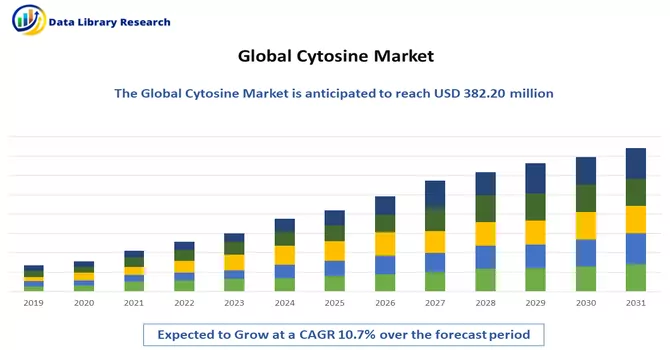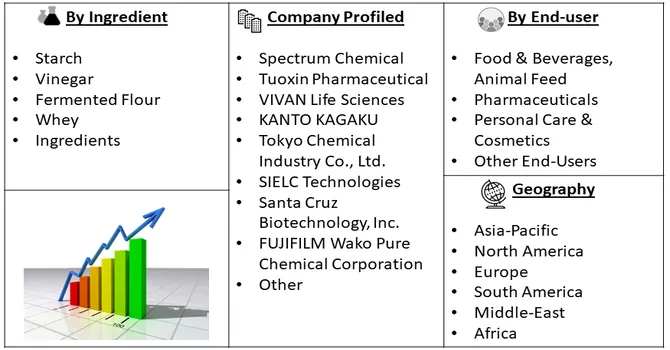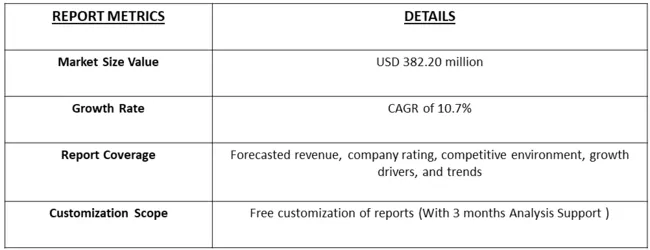The global cytosine market size was estimated at USD 382.20 million in 2023 and is projected to grow at a compound annual growth rate (CAGR) of 10.7% in terms of revenue from 2024 to 2031.

Get Complete Analysis Of The Report - Download Free Sample PDF
Cytosine is one of the four nucleobases that constitute the building blocks of DNA (deoxyribonucleic acid) and RNA (ribonucleic acid). It is a pyrimidine derivative, paired with guanine in DNA and RNA through hydrogen bonds. Cytosine is essential for the genetic code and plays a fundamental role in the transmission of genetic information during processes like DNA replication and transcription. In DNA, cytosine pairs specifically with guanine, forming a complementary base pair. The sequence of these base pairs encodes genetic information and instructions for cellular functions. Understanding the structure and function of cytosine is crucial in the study of genetics and molecular biology.
The increased utilization of cytosine in key industries such as agriculture, pharmaceuticals, and chemicals is driving its global demand. Notably, the pharmaceutical sector plays a pivotal role in influencing the trends and market dynamics of cytosine. Pharmaceutical companies are consistently in search of novel molecules and compounds with therapeutic potential, and cytosine finds extensive use in the synthesis of various pharmaceutical products. These include antiviral drugs, anticancer agents, and nucleoside analogues. The pharmaceutical industry's heightened focus on genomics and personalized medicine has further intensified the demand for cytosine. The compound's versatile applications and integral role in drug development underscore its significance in shaping and meeting the evolving needs of the pharmaceutical sector, thereby contributing to the overall growth of the global cytosine industry.
Market Segmentation: The Cytosine Market is Segmented by Ingredient (Starch, Vinegar, Fermented Flour, Whey, and Other Ingredients), End-use (Food & Beverages, Animal Feed, Pharmaceuticals, Personal Care & Cosmetics, and Other End-Users) and Geography (North America, Europe, Asia-Pacific, South America, and Africa). The market size and forecast are provided in terms of value (USD million) for the above segments.

For Detailed Market Segmentation - Download Free Sample PDF
The cytosine market is experiencing dynamic trends, with a prominent surge in demand driven by the pharmaceutical industry's relentless pursuit of therapeutic innovations. Cytosine's integral role in synthesizing pharmaceutical products, including antiviral drugs, anticancer agents, and nucleoside analogues, underscores its significance in drug development. The industry's heightened emphasis on genomics and personalized medicine further propels cytosine's demand. Additionally, the agricultural sector is embracing cytosine for the formulation of crop protection products, contributing to the compound's diverse applications. Ongoing research and development initiatives are fostering innovation, while global expansion strategies and market penetration efforts aim to capitalize on its growing demand worldwide. Regulatory compliance remains paramount, ensuring the adherence to quality standards. These collective trends portray a vibrant and evolving cytosine market, reflecting its pivotal role across pharmaceuticals, agriculture, and beyond.
Market Drivers:
Growing Pharmaceutical Industry Demand
The global demand for cytosine is robustly fueled by its pivotal role in the pharmaceutical industry, where it serves as a fundamental building block in the synthesis of diverse therapeutic compounds. Pharmaceutical companies, in their ongoing quest for innovative drug candidates, recognize the versatile applications of cytosine in drug development. Cytosine's significance is particularly noteworthy in the production of essential pharmaceuticals, including antiviral drugs, anticancer agents, and nucleoside analogues. These applications are crucial in addressing various medical conditions, contributing to the compound's heightened demand. The continual research and development activities within the pharmaceutical sector, driven by the pursuit of novel and effective treatment options, further propel the demand for cytosine. As pharmaceutical companies focus on expanding their product portfolios and advancing medical solutions, cytosine remains an integral component, acting as a major driver in the global market. The compound's role in therapeutic innovation underscores its importance in shaping the pharmaceutical landscape and meeting the evolving healthcare needs of a global population.
Growing Agricultural Applications
The expanding use of cytosine in the agricultural sector serves as another key driver for the global market. Cytosine's applications in the formulation of agrochemicals and crop protection products play a crucial role in addressing challenges related to crop management and enhancing agricultural productivity. As the agricultural industry undergoes a transformative shift towards sustainability and efficiency, there is an increasing demand for innovative solutions, and cytosine emerges as a valuable component in this context. The compound contributes to the development of agrochemicals that aid in protecting crops from diseases and pests, ultimately leading to enhanced crop yields. Agricultural stakeholders are increasingly recognizing the importance of effective crop management strategies to meet the rising global demand for food while ensuring environmental sustainability. In this pursuit, the demand for cytosine in the agricultural sector is on the rise, positioning it as a significant driver in the global market. As the industry continues to prioritize sustainable and efficient practices, cytosine's role in contributing to enhanced crop yields and addressing agricultural challenges is expected to further propel its demand and market growth.
Market Restraints:
Cost and Production Challenges
The global cytosine market faces a significant restraint linked to cost and production challenges. The synthesis of cytosine involves intricate and resource-intensive processes, contributing to a relatively high production cost. The complexity of the synthesis procedures can necessitate specialized equipment, skilled labor, and stringent quality control measures, all of which contribute to the overall expenses associated with cytosine production. Moreover, challenges related to production efficiency and scalability further compound the cost-related issues. Achieving consistent production efficiency on a large scale can be a complex task, impacting the cost-effectiveness of cytosine manufacturing. These cost and production challenges act as barriers to market entry, particularly for new entrants or smaller players who may find it economically challenging to compete. In cost-sensitive markets, where price considerations significantly influence purchasing decisions, the high production costs associated with cytosine may limit its widespread adoption. As a result, the industry must address these challenges to enhance cost-effectiveness, promote market accessibility, and foster the overall growth of the global cytosine market.
The global cytosine market experienced the impact of the COVID-19 pandemic, as disruptions in supply chains, logistical challenges, and economic uncertainties influenced market dynamics. The pandemic-induced disruptions in manufacturing and distribution affected the production and availability of cytosine, contributing to fluctuations in the market. Additionally, the pharmaceutical and agricultural sectors, major drivers for cytosine demand, faced challenges in research and development activities, impacting the overall consumption patterns. The economic downturn and uncertainties during the pandemic led to cautious spending, affecting the market, especially in cost-sensitive regions. Despite these challenges, the essential role of cytosine in pharmaceuticals and agriculture highlights its resilience. As the global economy gradually recovers, the cytosine market is expected to adapt and rebound, driven by the continued demand in crucial sectors and ongoing efforts to address challenges posed by the pandemic.
Segmental Analysis:
Chemical Industry Segment is Expected to Witness Significant Growth Over the Forecast Period
In the chemical industry, cytosine plays a pivotal role as a fundamental building block for the synthesis of various compounds and specialty chemicals. Its versatile chemical properties make it valuable for the creation of innovative chemical structures, contributing to the development of new materials and products. Cytosine's applications extend to the production of specialty chemicals, pharmaceutical intermediates, and other chemical formulations. Its incorporation in chemical processes adds a unique dimension to molecular design and enables the creation of compounds with diverse functionalities. The chemical industry leverages cytosine as a key component in the quest for novel chemical structures, facilitating advancements in material science and catalyzing innovation across various chemical applications.
North America Region is Expected to Witness Significant Growth Over the Forecast Period
In the North America region, the impact of the cytosine market is significant, driven by the region's dynamic pharmaceutical and agricultural sectors. Cytosine, a key player in drug development, finds extensive use in the synthesis of pharmaceutical products, including antiviral drugs and nucleoside analogues, contributing to advancements in healthcare. The robust demand from the pharmaceutical industry, coupled with ongoing research and development activities, propels the growth of the cytosine market in North America. Additionally, the compound's application in agricultural practices, aiding in the formulation of crop protection products, aligns with the region's emphasis on sustainable and efficient agricultural solutions. The North American market serves as a hub for innovation and technological advancements, shaping the trajectory of the cytosine market by fostering collaborations and driving the adoption of this versatile compound across diverse applications.

Get Complete Analysis Of The Report - Download Free Sample PDF
The analyzed market exhibits a high degree of fragmentation, primarily attributable to the presence of numerous players operating on both a global and regional scale. The competitive landscape is characterized by a diverse array of companies, each contributing to the overall market dynamics. This fragmentation arises from the existence of specialized solution providers, established industry players, and emerging entrants, all vying for market share. The diversity in market participants is underscored by the adoption of various strategies aimed at expanding the company presence. On a global scale, companies within the studied market are strategically positioning themselves through aggressive expansion initiatives. This often involves entering new geographical regions, targeting untapped markets, and establishing a robust global footprint. The pursuit of global expansion is driven by the recognition of diverse market opportunities and the desire to capitalize on emerging trends and demands across different regions. Simultaneously, at the regional level, companies are tailoring their approaches to align with local market dynamics. Regional players are leveraging their understanding of specific market nuances, regulatory environments, and consumer preferences to gain a competitive edge. This regional focus allows companies to cater to the unique needs of local clientele, fostering stronger market penetration. To navigate the complexities of the fragmented market, companies are implementing a range of strategies. These strategies include investments in research and development to stay at the forefront of technological advancements, mergers and acquisitions to consolidate market share, strategic partnerships for synergies, and innovation to differentiate products and services. The adoption of such multifaceted strategies reflects the competitive nature of the market, with participants continually seeking avenues for growth and sustainability. In essence, the high fragmentation in the studied market not only signifies the diversity of players but also underscores the dynamism and competitiveness that drive ongoing strategic maneuvers. As companies explore various avenues for expansion, the market continues to evolve, presenting both challenges and opportunities for industry stakeholders.
Key Cytosine Companies:
Recent Developments:
1) In May 2023, HuidaGene Therapeutics made a groundbreaking announcement by successfully achieving the conversion of guanine into cytosine, a transformative development known as G-to-Y, through their guanine base editor (gGBE). This breakthrough in genome editing represents a significant stride in manipulating genetic material, offering new possibilities in genetic engineering and therapeutic applications. By applying for an international patent for the guanine base editor, HuidaGene Therapeutics secures exclusive rights to this innovative technology globally. This achievement not only positions the company as a pioneer in genome editing but also opens avenues for novel treatments and interventions, showcasing the potential to precisely modify genetic sequences for therapeutic purposes. The international patent underscores the global impact and recognition of HuidaGene Therapeutics' groundbreaking work, marking a pivotal moment in the field of genome editing and its far-reaching implications for the future of biotechnology and medicine.
Q1. What was the Cytosine Market size in 2023 ?
As per Data Library Research the global cytosine market size was estimated at USD 382.20 million in 2023.
Q2. At what CAGR is the Cytosine market projected to grow within the forecast period?
Cytosine Market is projected to grow at a compound annual growth rate (CAGR) of 10.7% over the forecast period.
Q3. What are the Growth Drivers of the Cytosine Market?
Growing Pharmaceutical Industry Demand and Growing Agricultural Applications are the Growth Drivers of the Cytosine Market.
Q4. Which Region is expected to hold the highest Market share?
North America region is expected to hold the highest Market share.
Data Library Research are conducted by industry experts who offer insight on industry structure, market segmentations technology assessment and competitive landscape (CL), and penetration, as well as on emerging trends. Their analysis is based on primary interviews (~ 80%) and secondary research (~ 20%) as well as years of professional expertise in their respective industries. Adding to this, by analysing historical trends and current market positions, our analysts predict where the market will be headed for the next five years. Furthermore, the varying trends of segment & categories geographically presented are also studied and the estimated based on the primary & secondary research.
In this particular report from the supply side Data Library Research has conducted primary surveys (interviews) with the key level executives (VP, CEO’s, Marketing Director, Business Development Manager and SOFT) of the companies that active & prominent as well as the midsized organization
FIGURE 1: DLR RESEARH PROCESS

Extensive primary research was conducted to gain a deeper insight of the market and industry performance. The analysis is based on both primary and secondary research as well as years of professional expertise in the respective industries.
In addition to analysing current and historical trends, our analysts predict where the market is headed over the next five years.
It varies by segment for these categories geographically presented in the list of market tables. Speaking about this particular report we have conducted primary surveys (interviews) with the key level executives (VP, CEO’s, Marketing Director, Business Development Manager and many more) of the major players active in the market.
Secondary ResearchSecondary research was mainly used to collect and identify information useful for the extensive, technical, market-oriented, and Friend’s study of the Global Extra Neutral Alcohol. It was also used to obtain key information about major players, market classification and segmentation according to the industry trends, geographical markets, and developments related to the market and technology perspectives. For this study, analysts have gathered information from various credible sources, such as annual reports, sec filings, journals, white papers, SOFT presentations, and company web sites.
Market Size EstimationBoth, top-down and bottom-up approaches were used to estimate and validate the size of the Global market and to estimate the size of various other dependent submarkets in the overall Extra Neutral Alcohol. The key players in the market were identified through secondary research and their market contributions in the respective geographies were determined through primary and secondary research.
Forecast Model
